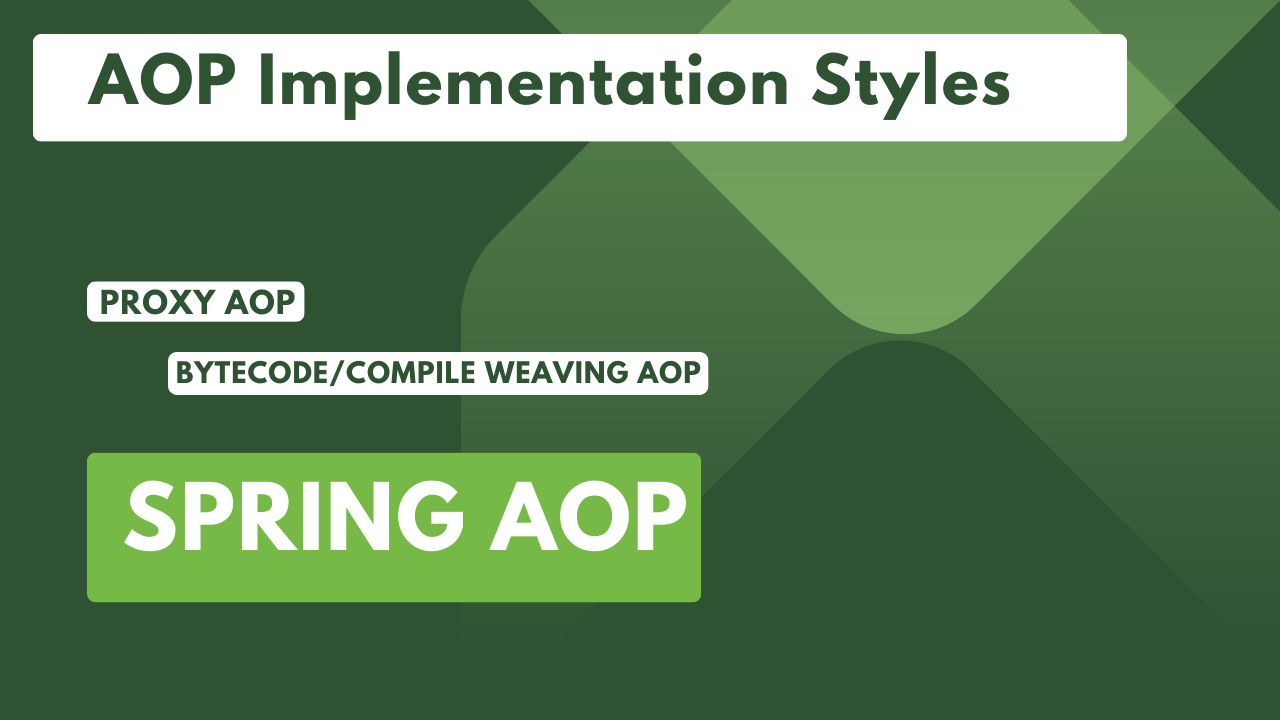AOP in Java and Implementation Styles
17 May 2023 | 3 min read | spring aop
Aspect-Oriented Programming (AOP) is a programming paradigm that enables modularizing cross-cutting concerns in software systems. It
provides a way to separate these concerns from the core business logic, resulting in cleaner and more maintainable code. AOP achieves this
by adding additional behavior to the existing code without modifying the original implementation. In Java, AOP can be implemented using
different styles, such as proxy-based AOP and bytecode weaving or compile-time weaving.

Proxy-based AOP:
In proxy-based AOP, dynamic proxies are created to intercept method calls and apply advice. Proxies are created at runtime and wrap the target objects. They intercept method invocations, allowing additional behavior to be applied before or after the method execution. This approach enables loose coupling between the core business logic and the cross-cutting concerns.
Example:
Consider a logging aspect that adds logging before and after method invocations in a UserService:
public interface UserService {
void createUser(String username);
void deleteUser(String username);
}
public class UserServiceImpl implements UserService {
public void createUser(String username) {
// Business logic
}
public void deleteUser(String username) {
// Business logic
}
}
public class LoggingAspect {
public void beforeAdvice() {
System.out.println("Logging before method execution");
}
public void afterAdvice() {
System.out.println("Logging after method execution");
}
}
public class Main {
public static void main(String[] args) {
UserService userService = new UserServiceImpl();
UserService proxy = (UserService) Proxy.newProxyInstance(
UserService.class.getClassLoader(),
new Class[]{UserService.class},
(proxyObj, method, methodArgs) -> {
LoggingAspect aspect = new LoggingAspect();
aspect.beforeAdvice();
Object result = method.invoke(userService, methodArgs);
aspect.afterAdvice();
return result;
});
proxy.createUser("John");
proxy.deleteUser("John");
}
}
Bytecode Weaving or Compile-time Weaving:
In this style, the aspect is applied to the target objects by modifying the bytecode of the classes at compile-time or during the weaving process. The aspect is woven directly into the class files, enabling the additional behavior to be applied without the need for proxies at runtime. AspectJ is a popular framework that implements this style.
Example: Consider an authorization aspect that checks user permissions before method invocations in a ProductService:
public class ProductService {
public void addProduct(Product product) {
// Business logic
}
public void deleteProduct(Product product) {
// Business logic
}
}
public aspect AuthorizationAspect {
before(Product product):execution(void ProductService.addProduct(Product))&&args(product){
// Authorization logic
System.out.println("Checking user permissions before adding product");
}
before(Product product):execution(void ProductService.deleteProduct(Product))&&args(product){
// Authorization logic
System.out.println("Checking user permissions before deleting product");
}
}
public class Main {
public static void main(String[] args) {
ProductService productService = new ProductService();
productService.addProduct(product); // Authorization aspect is applied
productService.deleteProduct(product); // Authorization aspect is applied
}
}
Spring’s Approach:
Spring AOP primarily uses the proxy-based AOP style. It dynamically creates proxies around the target objects to intercept method invocations and apply advice. It leverages the JDK dynamic proxies or CGLIB proxies to create these proxies at runtime. Spring AOP is declarative and can be configured using annotations or XML-based configurations, allowing for easy integration with Spring applications.
Spring AOP primarily adopts the proxy-based approach, providing a seamless integration with Spring applications. Spring can work with AspectJ aspects, it does not use bytecode weaving or compile-time weaving as the default approach for its AOP implementation. These AOP styles enhance code modularity, improve maintainability, and promote separation of concerns in software systems.